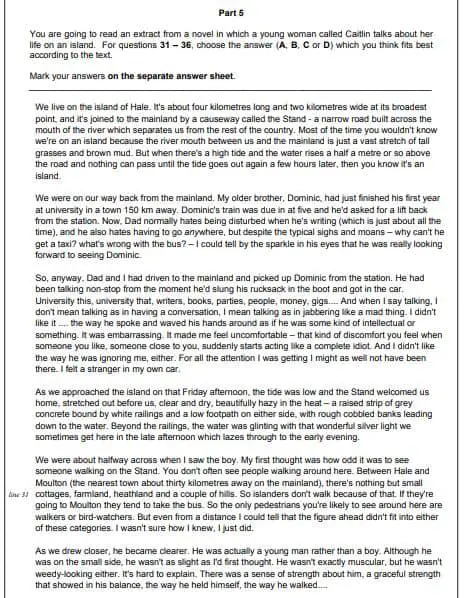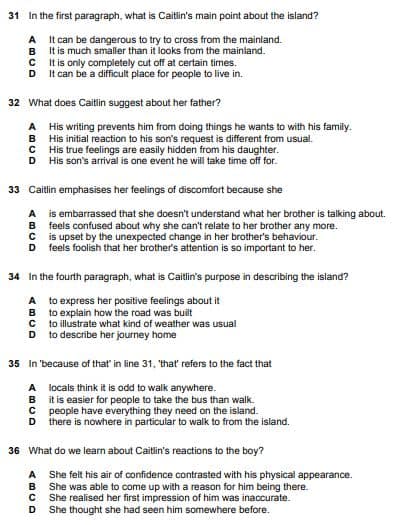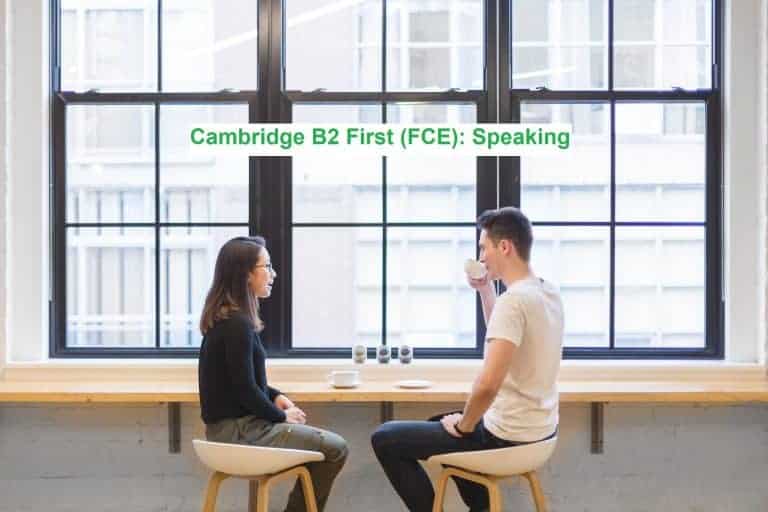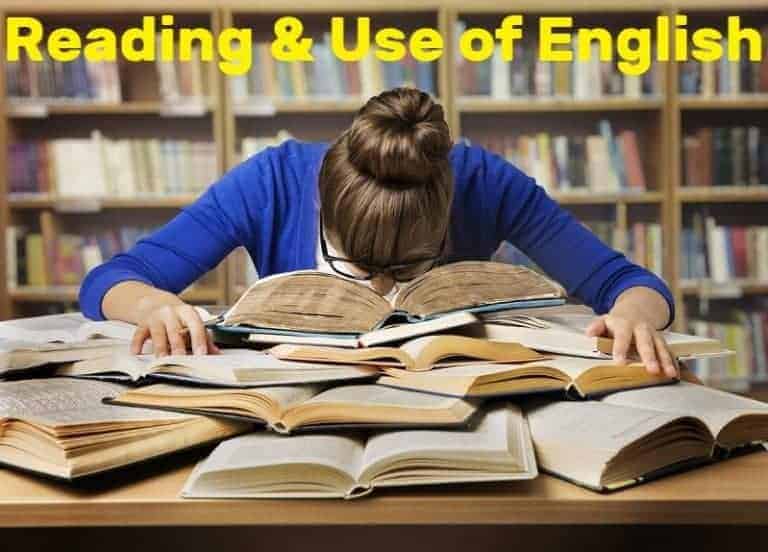Reading & Use of English Part 5
In this article you can find all the information you need about Reading & Use of English Part 5. Before you dive in, though, I recommend that you read about FCE in general. I have written posts for you to learn everything you need to know about Cambridge B2 First as well as Reading & Use of English so check them out, too.
Once you feel comfortable and you know where to start your journey you can find six more articles about this exam paper. Just click any of the buttons below to go down the rabbit hole and enjoy the ride.
What do you have to do in part 5?
Multiple choice. You read a text with around 650-700 words and answer six multiple-choice questions. The focus in this task is on many different reading skills like gist, detailed reading, the opinion or attitude of the author, etc.

As mentioned above, there are always six questions with four possible answers A-D. The first and the last question are often more general and ask about the author’s attitude or opinion while the other four are more specific. To find the correct answers you have to look for more detailed information in the text and quite often there is even one question (here question 35) that asks about a very specific word or expression in the text.

Reading & Use of English Part 5 tests your general understanding of a text as well as reading for detail and understanding of the author’s attitude and opinion. Together with parts 1, 6 and 7 it makes the reading portion of the exam paper. There is a post on teacherphill.com which explains to you exactly how Reading & Use of English is set up so I recommend reading it by clicking here.
The 3 most difficult things about this part?
This part, as well as parts 6 and 7 are the three parts in which you have to read pretty long texts so there are some specific issues, but also some problems that we can see in nearly every part of the exam paper. So first, let me show you what the most common problems are and then I’m going to walk you through the best tips & tricks.
1. Candidates want to answer the questions straight away
I know that it is very tempting to jump immediately into the answering part, but the questions are often designed to be little traps just waiting for you to fall into. I always recommend a slower approach with a good plan and step-by-step process so you don’t miss out on any marks. Take it easy and be like a hunter following her prey patiently before taking the shot. In the section on tips & strategies further below you will see exactly how to do that.
2. Candidates don’t know what to look for
This one is quite similar to the first problem, but instead of being too hectic and without a plan I want to talk about the questions and answers more specifically. As each question asks for different kinds of information – attitude, opinion, specific and detailed information, etc. – you have to be clear about what to look for in the text. Also, you can find all the possible answers somehow in the text, but you have to pick the one option that is 100% correct. If you don’t analyse the questions and answers carefully, you will lose marks, so work slowly and methodically.
3. Candidates have problems with time management
In part 5 you have to read quite a lot and many candidates have problems reading fast enough or they get confused and waste their time in other ways. Good time management strategies and planning are essential, especially in the last three tasks if you want to pass AND save time to complete the rest of Reading & Use of English.
Tips & strategies
Studying for the FCE exam can be overwhelming with so many things to keep in mind. There are different exam papers with several parts in each of them and before you know it you find yourself confused and ready to give up. The best piece of advice I can give you is to find out what exactly you have to do in each part and make a plan. The best thing is that I am here to do that for you. In each of my articles there are a ton of useful tips which I have put together for you so there is no need for panic attacks. Just focus on the important things and you’ll be fine.
I always tell my students that only practice makes you better. Therefore, you have to read regularly if you want to pass Reading & Use of English. If you make reading a habit, your reading speed as well as your level of comprehension will improve. In part 5 you are tested in different areas of reading comprehension so it is a good idea to create a little ritual of a few minutes of active practice every day. For Reading & Use of English Part 5 I recommend looking at interviews with famous people. Interviewers often ask them questions about their success and work ethic so you can get information that is similar to the questions you have to answer in the exam like their attitude and opinions on different topics.
As I mentioned in the section above, way to many candidates enter the exam without a plan so they waste time and lose a lot of marks. Being able to stick to an easy step-by-step process will give you a little advantage. In part 5 your plan could (and should) look something like this:
- Read the text quickly
- Analyse the questions (not the answers)
- Try to answer the questions (without options A-D)
- Compare your answers with options A-D
- Check the text again if you have to
1. Read the text quickly
It is always a good idea to have a look at the whole text before jumping directly into answering the questions. Because the text is quite long you have to read pretty quickly. Otherwise, you might not have enough time left for the other tasks.
By reading the text once you learn about the topic and general idea of the text. You already know what is happening without looking for specific information and this general understanding can help you complete the task and ,especially, with the first and the last question.
2. Analyse the questions (not the answers)
Now it is time to look at the questions. Read them very carefully and underline important words. Do not look at the answers, yet. Cambridge tries to confuse you, but we won’t let them do that. We go step by step like the tortoise in the race against the hare. Slow and steady wins the race so make sure that you know exactly what you have to look for in the text.
![]()
In the example above there are two important points to focus on: ‘the first paragraph’ and ‘Caitlin’s main point’, which tell us where in the text we have to look and that we have to find her general opinion about the island. That’s a good start and we can begin to read with confidence. At this point, I don’t want you to worry about the possible answers. Three of the four options are only there to confuse you so ignore them. Go to step three and stay on target.
3. Try to answer the questions (without options A-D)
Now we test our own comprehension skills without any help (nor confusing wrong options). Look at the paragraph below and try to answer the question from before by yourself.

What did you find out? To summarise, Caitlin just describes the island and the connection to the main land. She also says that you can’t sometimes get there because the road gets covered with water. That’s pretty much it…and easy as well, isn’t it?
4. Compare your answers with options A-D
I know you are already excited about the possible answers so, finally, let’s have a look and see if we find one that matches our own answer.

In the text Caitlin doesn’t talk about dangerous crossings (option A), nor the impression you get from the mainland (B) nor if it is difficult to live there (D). Option C, however, describes quite well what we found in the previous step so we can be certain that C is the correct answer.
You see, without looking at the possible answers too early we avoid having different ideas in our mind before we even start reading. Keep your head clear at first and then compare what you find with the available options.
Let me add just two more things before we move on to step 5. Firstly, some of the questions in Reading & Use of English Part 5 are incomplete sentences like the one below.
![]()
Please be careful to check that the WHOLE sentence matches the information in the text and not just the part in the answer so read both parts together and double check before making a decision.
Another tricky thing which costs many candidates their marks is what we can call ‘word spotting’. In our example above we find the word ‘mainland’ in the text as well as in options A and B. A lot of students feel as if one of these options must be the correct one even though A and B don’t match the information in the text at all. I created step 3 to avoid this trap as you answer the question by yourself first and then compare your full answer rather than looking at single words. Having a plan does help so make one.
5. Check the text again if you have to
Hopefully, you did such a good job in steps 1-4 that you don’t even have to worry about this one. However, sometimes we aren’t sure which option to choose because more than one show similarities with our own answer. In this case, simply go back to the text, read the part again in more detail and then decide which option is the best one.
Other tips
In Reading & Use of English Part 5 you get 2 marks for each correct answer so it makes sense to spend a little bit more time on this task. If you get full marks in parts 5 and 6, you have already passed the reading portion of the exam so try to get it right. I wrote an article for you about how you can calculate your score in FCE and how many marks you need to pass in each exam paper if you want to know more about it.
One other thing that people often pay little or no attention to is how to order the tasks in Reading & Use of English. There is a reading portion as well as a Use of English portion in this paper, some tasks carry 1 and others 2 marks for a correct answer and you might have your unique strengths and weaknesses when it comes to grammar, vocabulary and reading. With so many variables it makes a lot of sense to look at the different tasks and put them in a sequence that is perfect for you. Over the years I have found different ways to do this and spent a lot of time putting everything together in this article.
What about the other parts?
Do you want to find out more about the rest of Reading & Use of English? Just click the buttons below and learn more about all the different parts so you know exactly what mistakes to avoid and the best strategies to pass.
Lots of love,
Teacher Phill 🙂







